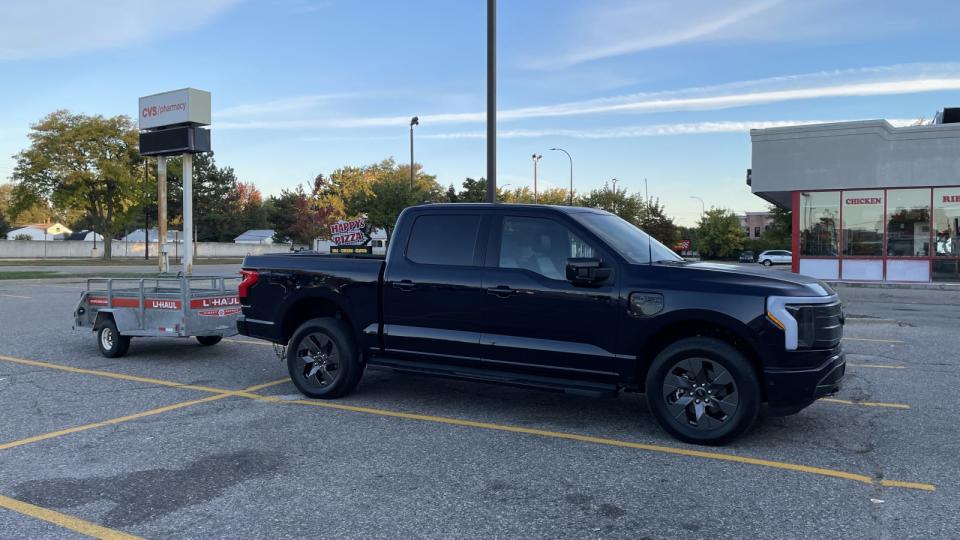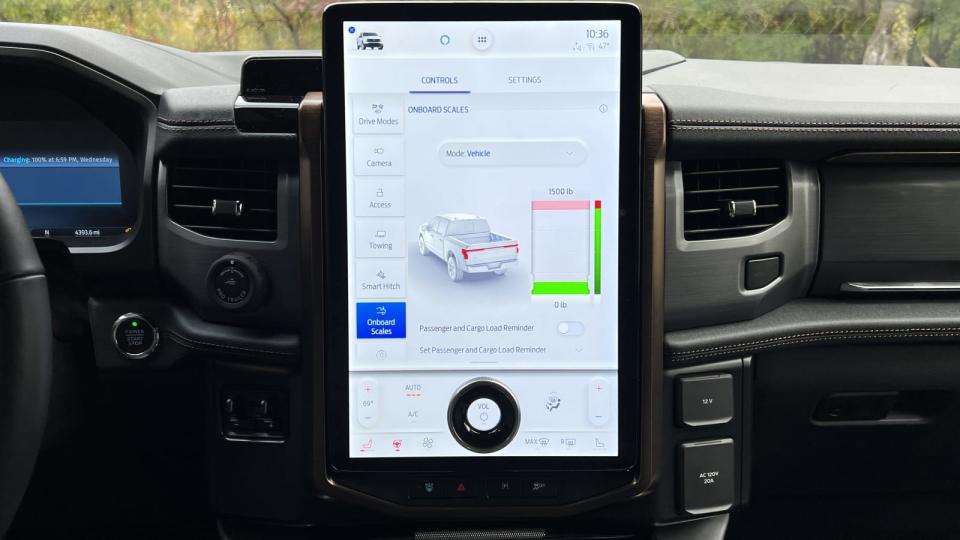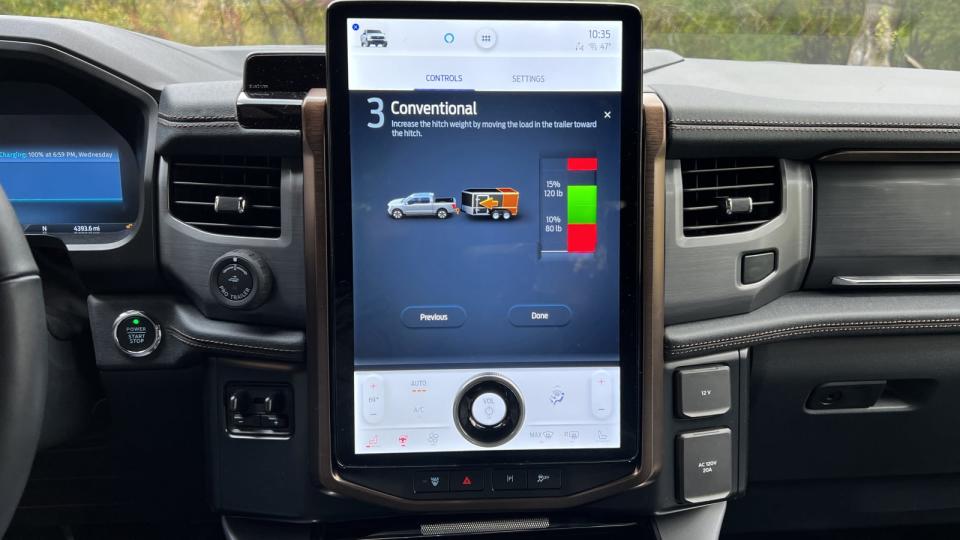Ford’s Onboard Scales and Smart Hitch win the 2022 Autoblog Technology of the Year award

The 2022 Autoblog Technology of the Year award goes to Ford for the Onboard Scales and Smart Hitch hauling and towing features found in the F-150 lineup. This new technology, as tested in the 2022 Ford F-150 Lightning, is a boon to pickup truck owners. Not only will it make observing your truck’s maximum loads easier and more intuitive, but it will also ensure you’re hauling and towing in the safest-possible manner.
We began the process with a long list of features to test and whittle down. Technologies like Mercedes’ new electric turbocharger, GM’s Super Cruise with added towing capability and many more went through the consideration process, but we finally whittled the field down to just three finalists. They are: the GMC Hummer EV with its flashy CrabWalk four-wheel-steer technology, the Genesis GV60 with its facial recognition/fingerprint start technology, and of course Ford’s trucking gear.
As is the norm for our Technology of the Year award, three main questions are asked, and editors assign point values based on how well the technologies perform in testing. How significant is this tech? How well does it work? And new for this year: Consider the Wow Factor.
With the scores tallied, the Ford tech earned 123 points, topping the Hummer (117 points) and GV60 (108). This is the second straight win for Ford, which won the 2021 TOY Award with its Pro Power Onboard charging feature.
Ford joins Tesla (2014, 2016) as the only two-time winner of our Tech of the Year Award, which dates to 2013. Kia, Cadillac, Tesla, BMW, Chevy, Chrysler and Audi technologies are among the previous winners.
While systems that tow and haul may not seem to be the latest or most sophisticated tech, they remain essential and Ford uses things like the infotainment system, taillights and the Ford mobile app to create a forward-looking experience Henry Ford would never have dreamed of when the first Model Ts were outfitted with beds for farm and war duty in 1917. Even 10 years ago, integrating tech in this manner would have seemed futuristic, but Ford pulls it off.
“Ford’s clever towing and hauling features earned our award this year because they are easy to use, easy to understand and simply make your life as a truck owner better,” Autoblog Editor-in-Chief Greg Migliore said. “It was a competitive field this year, with Hummer’s CrabWalk and Genesis’s Biometrics features both winning strong support. But Ford came out on top with smart technologies that are well-executed and should stand the test of time.”
Towing and hauling can be tricky. If you don't tow or haul heavy loads often, there’s a lot to learn and a lot of ways you can screw it up. With the F-150’s Onboard Scales and Smart Hitch system, Ford is removing a good chunk of the guesswork from these jobs using smart technology.
Onboard Scales is the easiest one to grasp. Every truck has a maximum payload capacity rating. Your particular truck’s rating will vary based on the configuration and how it’s equipped — exact amounts will even vary based on options, as some may add considerable weight to the truck thereby lowering payload capacity. Manufacturers always like to quote the highest capacity in the lineup as the headline figures when they reveal new vehicles, so it’s up to you to figure out what your particular truck can carry. Instead of needing to do math with the GVWR (gross vehicle weight rating) and vehicle curb weight, the Onboard Scales menu in the F-150’s infotainment system tells you exactly what your maximum payload rating is. Plus, the system will account for weight that’s in the truck — such as additional passengers and gear — when it’s calculating how much it can bear.
The trickiest part in hauling things, though, may be determining the weight of the objects you’re hauling. Say you want to load up a couple thousand pounds of landscaping rocks to bring home, but you’re not sure if the lot of them weigh 2,000 or 2,500 pounds. Your truck may be rated for the former, but not the latter. Instead of guessing, simply start loading the cargo into the bed, and watch your Onboard Scales go to work. On the inside, you can see an easily readable scale that tells you how much weight is in the truck at any time. On the outside, the taillights will indicate approximate weight via bars that light up. You’ll notice the lights creep upward as you add more weight. If you go over the limit, the lights will flash as a warning — note that the Lightning doesn’t have the exterior light bars, so you’ll need to watch the dash or phone app to judge the weight with Ford’s electric pickup. And yes, if you’d rather see the weight on your phone, Ford’s app will inform you just the same as the infotainment system will.
In our testing, we used Autoblog staff members to see how the truck would react. Each extra person to hop in the bed of the truck — using the convenient bed step — would cause the scale inside to react and read a new weight rating.
Using this tool, you’ll never accidentally overburden your truck beyond its rated payload capacity again. Driving around in a truck with a weight over its maximum capacity makes it more dangerous to drive, and you could cause expensive damage to your truck while you’re at it. It makes all the sense in the world as a safety feature, and we expect other trucks to adopt it in the future.

The second part of Ford’s new towing/hauling package is Smart Hitch. This one’s all about towing and making sure you have the proper tongue weight via the connected trailer. Instead of you guessing how to distribute the weight on your trailer, the Smart Hitch does it for you. Say, you’re towing a car. Once you get the car onto the trailer, the Smart Hitch will tell you whether you need to move the car farther toward the front of the trailer or toward the rear to achieve the ideal tongue weight. Why is this good and necessary? A properly balanced setup will be far better and safer to drive. You’ll end up with less trailer sway, and the truck and trailer will be more controlled moving down the road.
We rented a trailer to test the Smart Hitch functionality, and once again commissioned Autoblog staff members to move around it to test its abilities. Every tester was able to direct the team to stand at the most optimum position within the trailer, so this tech passed testing with flying colors as well.
Similar to Onboard Scales, Smart Hitch is an excellent safety feature that will undoubtedly make life easier when towing, and we expect similar systems to be integrated into other vehicles in the future. The potential to integrate Smart Hitch into vehicles outside of pickups looks bright, too. There are so many new vehicles you can buy today with towing capability that would benefit from this tech being onboard. In fact, the benefits might be even greater on non-pickup vehicles, as there’s a decent chance you’ll find more first-time or beginner-level towers in these sorts of cars.

How does it work?
Ford was able to integrate these systems without much added complication to the truck. For the Onboard Scales feature, the truck uses already-present load-leveling sensors to measure the suspension’s deflection at each corner. Knowing both this and the truck’s spring rates, it can approximate how much weight is in the bed. You won’t get the exact weight reading on the screen down to a pound, but what’s truly important is that you understand how far or close you are to the maximum weight. The graphical representation of this is super-easy to comprehend in the infotainment system, and the light bars on the rear of the truck (each bar that lights up represents about 25 percent of the load capacity) make it even easier.
Smart Hitch uses the same sensors as Onboard Scales, but the setup is a little more involved. For starters, you’ll need to know your trailer’s weight. You also need to tell the truck whether you’re using a conventional, weight distributing, gooseneck or fifth-wheel hitch. Once all of your passengers are in the truck and gear is in the bed, you’re good to begin the setup process. Ford will guide you through a number of pages where you input the trailer weight before landing you on yet another scale. At this point, you can hitch up the trailer.

A horizontal line will show in the graph once hitched up, indicating if there is too much or too little tongue weight. You’ll need to move the weight around on your trailer to get it in the happy zone. Going back to our car analogy, moving the car further up and further back on the trailer will accomplish this goal. Ford even uses the taillight bars to its advantage again here. If the weight is distributed properly, the two middle lights will illuminate. If there’s too much tongue weight, the top bar flashes, and if there’s too little weight, the bottom bar flashes. This way you can optimize your load without even going back inside the truck to check.
Simplicity, added safety and influence on future products makes Ford’s smart towing and hauling tech our Technology of the Year award.

 Yahoo Autos
Yahoo Autos 
